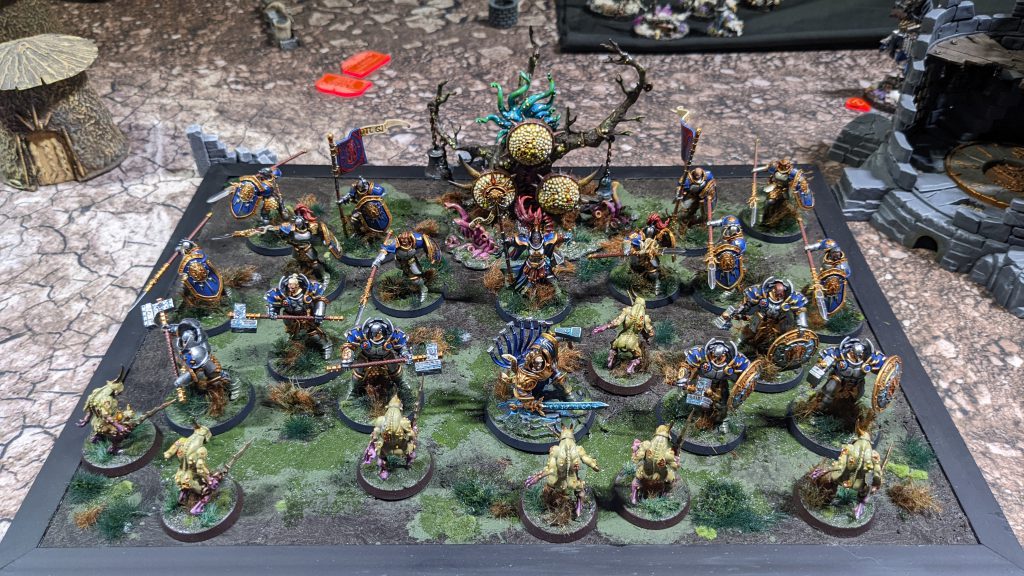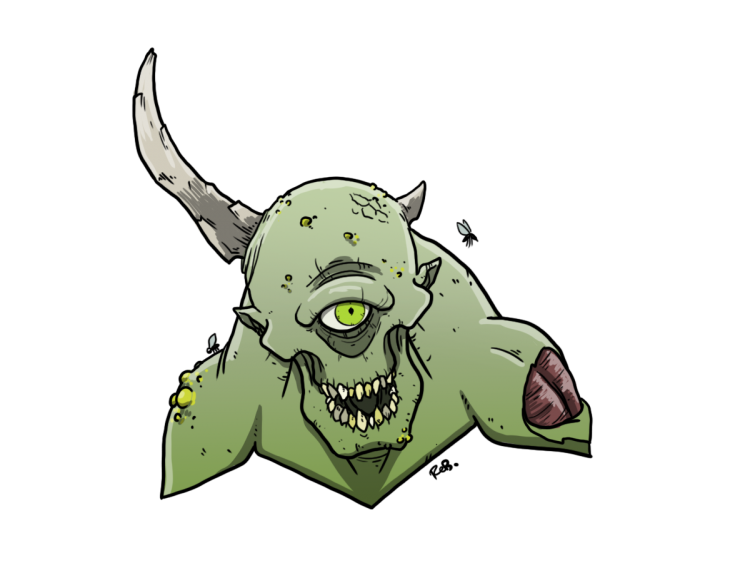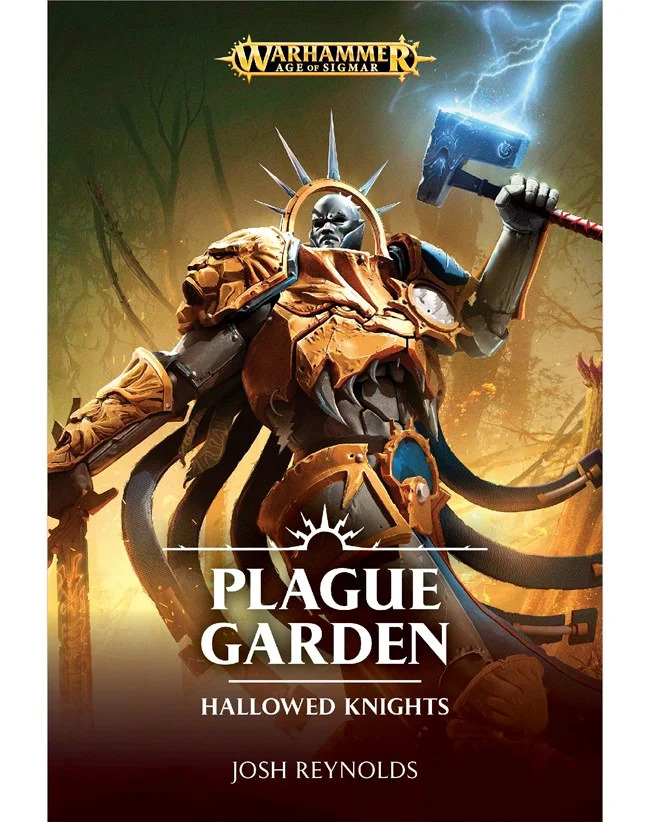Plague Garden by Josh Reynolds is one of the seminal early-days Age of Sigmar novels. It didn’t contain any meta-altering plot, but it did contribute massively to the tone and character of what would come after.
Indeed, any Age of Sigmar book that has the words Josh Reynolds on the cover is going to be a treat. I’m not sure any other author has done as much as Reynolds to shape the Mortal Realms; he world-builds so effortlessly and enduringly. The way he writes the setting puts you right there in the thick of this fantastical universe.
For a start, much of this book takes place in the Realm of Chaos itself, in Nurgle’s Garden. Such a vivid picture of that hellscape gives everything that happens in the Mortal Realms meaning and gravity – this is what the forces of order are fighting to prevent happening to their own homes. The little clues you get into what the Realm of Chaos once was, before Chaos took over, really makes it entirely possible that this could happen to the Mortal Realms.
The story focuses on the Ghyran front, just after the events of the Realm Gate Wars. The Stormcast Eternals, led by Lorrus Grymn, are attempting to further drive back Nurgle’s Rotbringers and liberate the Realm of Life. They target a Nurgle stronghold, some sort of putrefying seaweed fortress, and begin to hack their way through scores of Beasts of Chaos and Maggotkin in an attempt to shatter the enemy’s defenses, rescue prisoners and gain a strategic foothold.
During the onslaught, Lorrus Grymn learns that there is a corrupted Realm Gate in the basement that leads directly to Nurgle’s corner of the Realm of Chaos. While attempting to seal it, Grymn is sucked into it and becomes trapped in the Garden of Nurgle. Once there, he is captured by Gutrot Spume (who actually does talk like a pirate!) who sees the Stormcast hero as a sure way of regaining favour with the Plaguefather.
Gardus Steel Soul, of the Hallowed Knights, is sent to Ghyran to reinforce the Stormcast offensive. Upon arrival, he learns of Grymn’s fate. Despite the danger, and the smell, Gardus leads a small detachment of Stormcast into the corrupted gate to rescue their captured comrade from the very heart of Nurgle’s domain.

The story moves between grinding battle scenes and swash-buckling adventures. As Gardus and his band sail through the sludge of Nurgle’s corrupted waterways, battling all kinds of weird and wonderful creatures, I was often reminded of Jason and the Argonauts, but instead of claymation for SFX the filmmakers have cancer.
The action is engaging throughout, but, having said that, the one issue I have with the book does come in the action sequences. The Stormcasts slice their way through Nurgle’s forces somewhat effortlessly. Blightkings and Great Unclean Ones are just brushed aside like a knife through butter. Suddenly, AOS’s most durable and resilient army is being smacked about like they were little more than snotty-nosed toddlers.
I know it’s impossible for the books to mirror the game perfectly, and maybe I’m just a little offended, as a Nurgle player myself, but I just didn’t get a sense of peril from the book. By the time the dwindling group of Stormcast start grinding their way into the very heart of the Garden of Nurgle, I had already seen them blend through some of Nurgle’s toughest and most resilient servants with ease, so at no point did I think, “Oh shit, maybe they won’t make it.”
And whilst, technically, the stakes were high since Stormcast don’t get to reforge if they die in the Realm of Chaos, I just knew they’d make it anyway. Those that did die were hoovered up into a kind of soul vacuum along the way, so that they could be reforged once they had escaped.
It’s also worth keeping in mind that this book was early-days AOS, so it suffers the same issues early lore had in having Stormcast as the protagonists. They’re just not identifiable enough to us, mere mortal readers. Later books get to grips with this a little more, especially when the dehumanizing effects of reforging get explored in more detail, but I just found I couldn’t really get immersed in what was happening to the people in the book as much as I would have liked.
Having said that, there are some really interesting characters in this book, and they’re actually characters, with diverse personalities and everything. Some of them are even women! Plague Garden certainly plays its part in making AOS a more representative and inclusive universe; we see a rich cast of female Stormcast joining the narrative, and it’s all the richer for it.
Gardus is, of course, a really interesting character as well. He had such a key role in the Realm Gate wars, that writing for him must have been a really daunting task, but Reynolds treats us to a Gardus that is clearly human, we see him in Azyr, helmet off and chatting with colleagues, but also an inspirational leader oozing with integrity and charisma.

But the character who stands out the most is Tornus the Redeemed. Formerly Torglug, of Nurgle fame, he had killed scores of Stormcast and Sylvaneth upon his being corrupted. Nurgle had thrown him into a filth pit to be eternally tortured, until he finally cracked and pledged allegiance to Chaos.
Using Torglug’s knowledge of Ghyran, the forces of decay became virtually unstoppable. After spearheading numerous massacres of innocent people, and leading the hunt for Alarielle, Torglug’s face became one of the first things the newly recovered Ghal Maraz was introduced to by the Celestant Prime, but instead of condemning his soul to damnation, Sigmar redeemed it and reforged Torglug on the Anvil of Apotheosis as a Stormcast Eternal.
Earlier on in the book, we see Sigmar entrusting Gardus with the task of mentoring Tornus. Tornus therefore joins Gardus’ expedition into the Garden of Nurgle, and has to confront all of the terrible stuff he had done as Torglug, whist at the same time having to prove himself to the other Stormcast who feel, at best, conflicted about having someone on the team who had been mercilessly slaughtering them in the not too far distant past.
Tornus is a great vessel for exploring the themes of redemption and forgiveness. As the warband merrily hack away at Nurgle Rotbringers, Tornus is testimony to the fact that beneath all of the pus and guts, there is a human being who could, perhaps, be redeemed.
This theme is also explored through another Rotbringer general, Gatrog, who is captured by Gardus’ crew and forced to serve as a guide through Nurgle’s garden. Gatrog is a great character and, like Gutrot Spume and the other Nurgle champions we meet, is wonderfully written with all the tragedy and vomit inducing comedy (vomedy?) you’d expect from a child of the plaguefather.
Torglug and Garog, and the whole discussion around redemption, becomes a metaphor for what is happening in the AOS world at large. The Mortal Realms have become so hopelessly corrupted by the hand of Chaos, is it even possible for Sigmar to redeem them at all?
Plague Garden is one of the ‘must reads’ of Age of Sigmar, and despite its being written while the setting was still finding its feet, it still stands as one of the best novels the Mortal Realms has to offer.



You must be logged in to post a comment.